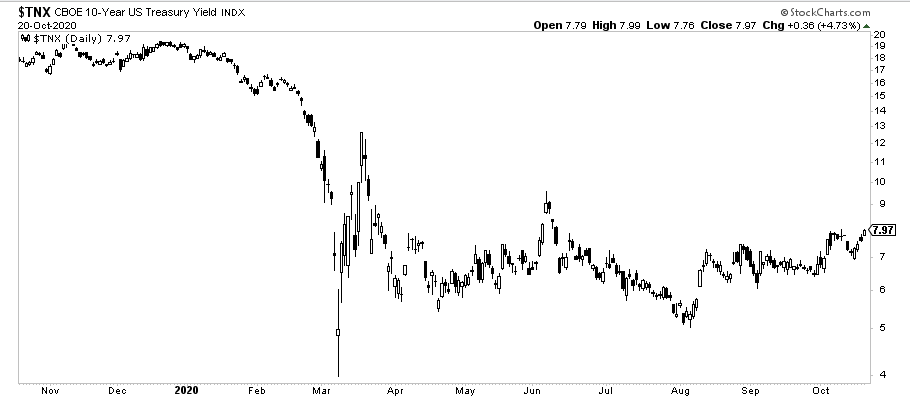What If Everyone is Right on Rates?
People who were buying homes in the 1970’s are probably laughing right now! They were taking out mortgages with rates in the mid-teens and we are getting concerned that yields may begin to move above 1%.
Interest rates are getting a lot of attention and for good reason. For the first time in a long time, there is scope for them to go higher. Maybe not back to the 2% - 3% range, but could the ten-year yield double from here? It could, and it would still be extremely low. A double from here would take this benchmark rate to a whopping 1.6%. Essentially back to where it was before COVID accelerated a move to the downside.

According to this article in The FT, betting on rising rates is becoming increasingly popular among the hedge fund set. Some have even called the trade crowded.

Per the article: Investors are running increasingly weighty bets that long-term US government bond prices are about to fall, anticipating that a Democratic win at next month’s US election and progress against Covid-19 could dent the haven assets.
I am not going to disagree with the call. I actually started writing about it in notes to clients on June 2nd where I had this to say:
In Fixed Income, the story remains much the same as it has for the past 12 months. Favoring treasuries makes the most sense. However, there are early indications that the move is toward the curve steepening.
Let’s be fair the better call would have been to move from treasuries entirely but we did a nice job of getting on the right side of the steepener, as long-dated treasures have underperformed their short-dated peers.
I am also not going to get into the debate about if this is truly a crowded trade and everyone piling in now is going to be wrong. I am interested, for now, in knowing what this could mean for the equity market. Over the past 63-days, the major equity ETFs that I track are all positively correlated to the 10-year yield, they tend to move in the same direction…just to varying degrees. It’s not very large either. A quick scan shows us that the most highly correlated is High Beta and most loosely correlated is Mid-Cap Growth. In fact, growth assets hold the bottom three slots.

Let’s unpack this a bit and assume that all the people betting on higher rates are correct. Let’s also assume that the Federal Reserve will give the market just enough rope, but no more. How should equity investors be thinking about their allocations if the ten-year yield is going to move from 0.80% to 1.6%? Would it make sense to be invested, in a big way, in some of the most popular growth names in the market right now. Names that are being driven by the promise of profits in the future. Names that are leveraged to “the cloud” or “big data” or “the human genome”?
To be clear, I am a believer in innovation and many innovative companies fall into this growth category. They are “story stocks” where the payoff will be (maybe) off in the future. However, I am fully aware of what can happen to these names in the event that rates move up, even if still low by any historical standard. Here is a simple and fast way to look at it. Let’s assume that a company is going to be worth $100 in ten years, how much should we pay for it today?
At an interest rate of 0.80%, $100 in ten years is worth $92.34 today.
At an interest rate of 1.60%, $100 in ten years is worth $85.32 today.
Without changing any other assumptions (which is a stretch) the 80 basis point move in rates took more than $7 off the value of the company today. In the real world, there would be other inputs which would likely make the hit to todays value more or less severe. The point is, the further into the future the promise of getting paid, the more a rise in rates could impact today’s price. Picking on Fastly one more time, they aren’t projected to turn a quarterly profit until the first quarter of 2022. What happens to a stock like this, all else being equal, if rates rise?

Here is what I wrote to clients in my morning note yesterday as it relates to the weakness in long-term treasuries:
The long bond remains under pressure after breaking near-term support in late-September. The iShares 20+ Year Treasury Bond ETF has a Very Bearish Rating as it trades below the declining long-term trend line. This is an important development because as it falls, yields rise which could have a negative impact on the high-flying speculative growth stocks.
Does this mean that I no longer think that innovative companies deserve a spot in the portfolio? Of course not. I am believer in the ARK theory that it should be its own asset class. But, do I think it should be a very large allocation? That depends on risk tolerance and timeframe. The answer is different for everyone. I do know that if I was invested in these growth and innovation themes (I am) I would be paying really close attention to what is happening with interest rates (I am). What would get me to sit up and take action? If the rate on the TNX chart above moved through 9 (0.90%).



